Is it possible to transport a refrigerator lying down? Rules and standards for the transportation of refrigerators
Are you thinking about transporting refrigeration equipment in connection with the purchase of a new model or a change of residence? Agree: it’s stupid to ruin expensive equipment due to violation of the rules for organizing transportation. Therefore, it is better to find out in advance whether it is possible to transport the refrigerator lying down and how best to do this.
We will help you dispel all doubts. The article discusses the main methods of placing a refrigeration unit for its safe transportation. Attention is also paid to properly preparing the refrigerator for moving, and problems that may be encountered are listed.
So that you don’t have any questions about transportation, we have provided the article with visual photos and selected videos with recommendations for preparing the refrigerator and its placement when changing your place of residence.
The content of the article:
The important role of correct position
Refrigeration equipment from different brands works on a similar principle. The cooling system is a closed circuit consisting of many thin tubes.
Conventionally, it is divided into two parts: the evaporator, located inside, and the condenser, installed on the outer rear wall. Basically, these components are implemented in the form of a coil, which contributes to the effective absorption and release of heat.
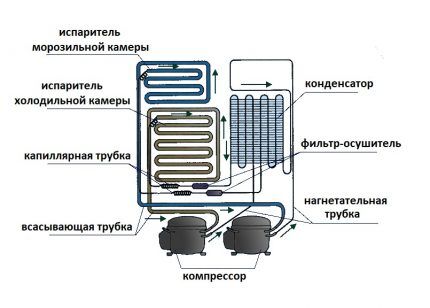
The working system of the refrigerator is filled with freon, which continuously moves through the tubes, alternately changing its state of aggregation.
Cooling cycles follow the same pattern:
- gaseous refrigerant is pumped out of the evaporator and enters the compressor;
- the substance is compressed and sent under high pressure to the condenser;
- during condensation, freon turns into liquid and cools, releasing heat to the environment;
- the liquid passes through the filter drier and is directed towards the evaporator, entering it through a narrowed capillary tube;
- the refrigerant pressure drops, causing it to boil;
- evaporating into gas, freon absorbs heat from the internal chambers, uniformly cooling the space.
Next, the freon vapor is pumped out again and the cycle repeats. The role of the main functional element in the process belongs to the compressor.
It pumps the refrigerant, creates the necessary pressure in each part of the system and is responsible for the uninterrupted transfer of heat from inside the device to the outside. Stable and silent operation of the motor is maintained by hanging it on the frame and immersing it in oil.
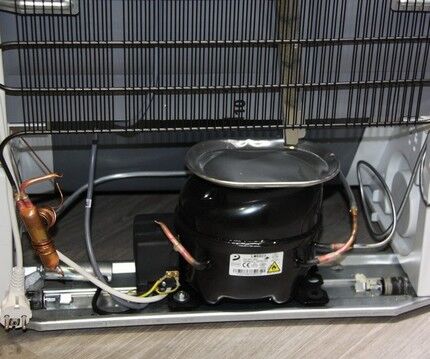
Any damage to the tube system, displacement or separation of the compressor from the suspensions leads to major damage that requires complex repairs.
The easiest way to disrupt the normal functioning of the cooling system is when transporting the product. That is why this issue must be approached with maximum responsibility.
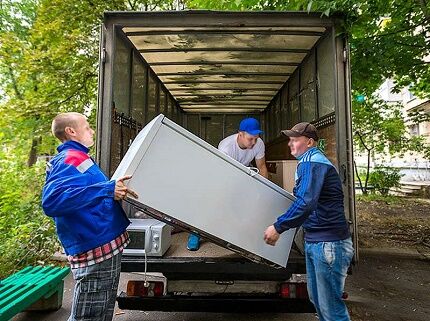
Preparing refrigeration equipment for moving
The famous writer Scott Westerfeld in one of his novels described moving as a terrible thing, after which you never know where you will find it and where you will lose it. And this is true - when transporting property from one point to another, there is a huge risk of damaging or losing something.
In order to prevent such troubles, you need to properly plan the process itself, conscientiously pack the cargo and securely secure it inside the truck.

If the refrigerator is new, the manufacturer must take care of its reliable and safe packaging even before the equipment reaches the store’s warehouse. If you intend to transport a unit already used on the farm, it is necessary to first prepare it for such a responsible operation.
Preparatory work usually begins 24 hours in advance, following the following procedure:
- empty the freezer compartment and refrigerator cabinet of existing products;
- disconnect the device from the power supply and wait for complete defrosting;
- Gently wash the inside and outside of the equipment with a neutral detergent (the best option is a warm soapy solution);
- remove all shelves, niches, drawers and balconies, packing each element separately in a piece of soft fabric or paper;
- drain the water and dry the insides thoroughly.
The compressor must be secured with shipping bolts or rope. Otherwise, due to strong shaking, vibrations and jolts, it can easily fly away from its place.The wire is carefully attached to the compressor with tape. In non-standard models of refrigerators that do not fit through the opening, the door is removed or the door frame is dismantled.

You can start loading only after completing all the described processes. Ignoring at least one of them often leads to incorrect operation of the device in a new location. To carry the unit from the room to the car and vice versa, at least two people will be required.
A trolley, a pallet with wheels, or special safety belts will help make the task easier. According to transportation standards, equipment is carried in an upright position. The device must be loaded and unloaded into a trailer or body smoothly and carefully, avoiding sudden jolts and impacts. In this case, you must not grasp the door handle.
This video will demonstrate how to properly pack a refrigerator before transportation:
Overview of possible transportation methods
Regardless of the dimensions of a particular model, experts strongly recommend transporting any refrigerator in a truck, placing it strictly vertically.
However, there are cases when it is impossible to transport equipment in this way due to the limited internal space of the car. In fact, three methods of placement are used: standing, inclined and lying down.
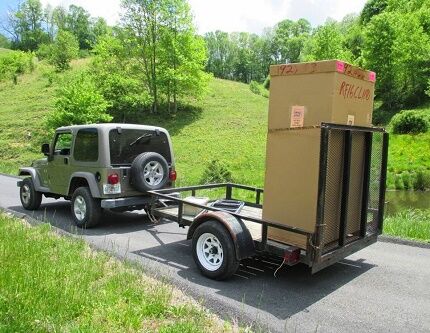
Option #1 - transportation in a vertical position
Transporting the refrigerator while standing is the most correct option, which is what manufacturers emphasize in the documentation supplied with the equipment. It ensures the safety of structural refrigeration components and their normal performance in the future.

First of all, prepared by the manufacturer for transportation purchased refrigerator carefully carried and placed in the car.
In the cabin, it is firmly secured in a designated place with belts and additional stops that prevent unwanted shifts during sudden braking, bumps and turns. The reliability of door fixation is checked once again.

IN two-door models The tape is pasted in four places. Between the floor of the cabin and the body of the device, any available material is placed that will perform shock-absorbing functions on the road and protect the paint from damage: polystyrene foam, cardboard from old boxes, several layers of thick cloth.
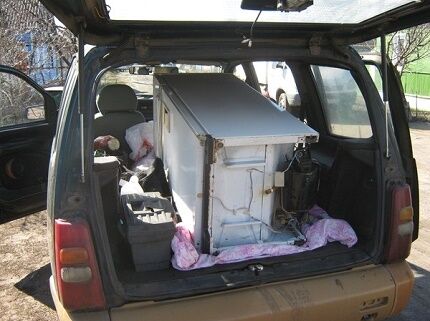
Option #2 - transportation at an angle
Without the opportunity to use a car with a high van, it is difficult to transport refrigerators longer than 1.75 meters in a vertical position. If the device does not fit in the cabin at full height, installation at a slight angle is allowed. The tilt angle should not exceed 40 degrees.

Having placed it in this position, you should secure the refrigerator well, place as many materials as possible on the side and under it to dampen vibration.
You must drive the vehicle carefully and carefully. It is important that the driver drives at a minimum speed and, if possible, avoids the slightest potholes and holes found on the roads.
Option #3 - horizontal placement
When asked whether it is possible to place a refrigerator lying down in the cabin, experts give ambiguous answers. The instructions of the vast majority of refrigeration equipment manufacturers indicate that this should not be done, as there is a high probability of damage.
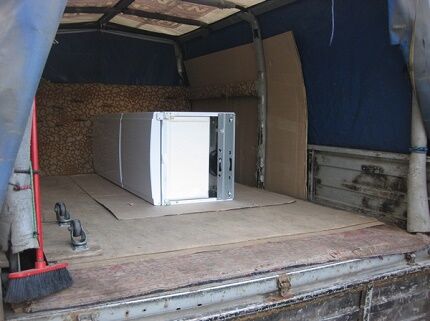
Masters involved in repairing household appliances claim that this is quite feasible, but only over not too long distances, taking into account a number of nuances and, as they say, at your own peril and risk.
However, the statistics are not so sad: in 10 cases, consequences occur in 3 of them.Moreover, they are associated more likely with the bumpy road, careless loading and carrying, and lack of good fastening of parts, than with the position of the equipment.
The unit must be laid on its correct side in a horizontal position. The side on which the compressor tubes exit should face upward. Another placement method may result in oil dripping, which then enters the circulation system and clogs the capillary tube.
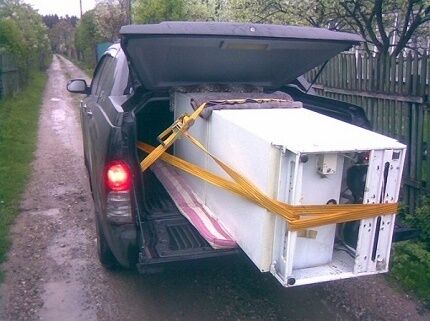
It is worth considering that lying down transportation is extremely undesirable for two types of equipment - old-style refrigerators produced in the Soviet Union, and new models with a built-in NoFrost system.
Durable and heavy-duty Soviet units are equipped with a very heavy motor, which easily breaks off the mounts during the shaking that is inevitable on the road. In modern products equipped with innovative technology, refrigerator compressor often detaches from the built-in inner spring.
The result is a complete failure or partial malfunction of the compressor, manifested in the form of extraneous noise and knocking.
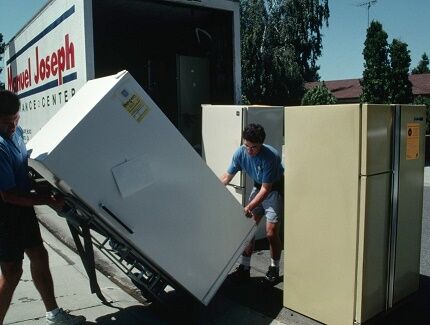
Problems with violation of transportation rules
By neglecting the established rules for transporting a refrigerator, equipment owners face many unpleasant consequences. The most common reason for panic occurs when, after installing in a new location and connecting to the network, the device refuses to work or is not functioning properly.

This often happens due to the mixing of wear products with oil, which causes the motor to jam in units that are already in use.
Another reason may be the fact that the oil that spread during transportation has not yet had time to fully drain back into the compressor. In turn, it will not start without sufficient lubrication.
In most cases, the problem can be dealt with without losses by allowing the equipment to settle and acclimatize: 8-16 hours after horizontal transportation, 2-4 hours in warm weather and 4-6 hours in frosty winter periods. The longer and more difficult the path, the more time it will take to rest still.

If after the specified time the refrigerator continues to work incorrectly, it makes sense to talk about more serious factors that caused the failure. One of the typical breakdowns includes freon leakage, caused by depressurization and various mechanical damage due to improper transportation of the device.
It is determined by several criteria:
- the compressor is running, but the cooling capacity of the device is noticeably reduced;
- the equipment does not turn on, but the lighting in the chamber works;
- after starting, the unit begins to function, but soon turns off;
- a sound or light indicator is triggered, signaling critical increases in temperature inside the device.
If you find similar signs, you need to find the place where the leak occurred, replace the filter drier and refill equipment with freon. This operation is quite complex and dangerous, so it is better not to try to cope with it on your own.
The next thing that can affect the operation of the refrigerator is a breakdown of the compressor. During transportation, contacts are often broken and the springs holding the rotor fly off.
Because of this, the device may not turn on at all, one of its sections stops working, and characteristic engine knock. Since the compressor has a non-separable design and has to be replaced with a new one, most likely the repair will be expensive.
Conclusions and useful video on the topic
Advice on transportation and explanation of the features of the equipment:
When purchasing a new refrigerator for your home, or moving to another place of residence, you need to think through all the possible nuances and properly organize its transportation..
Not only the preservation of the aesthetic appearance of the equipment, but also its stable and proper operation in the future depends on this.
Tell us about your own experience in transporting a refrigerator. Share the secrets of preparing the unit for transportation and the nuances of moving it. Please leave comments in the block form below, ask questions and post photos on the topic of the article.




As far as I know, refrigerators are always transported standing up; this is even marked on their original packaging. But there is such an interesting way to “revive” an old refrigerator, it was recommended to me a long time ago, I tried it myself.If the refrigerator does not freeze well, you need to put it down and leave it in that position for a day or two. The refrigerant will be redistributed and the refrigerator will freeze well again. I thought it was all nonsense until I checked it myself!
I wonder, when you order cargo transportation, are the movers responsible for observing the rules for transporting the refrigerator?! And how will it be possible, and is it even possible, to prove that the refrigerator was in working order before transportation, if something happens? It is impossible to revive the refrigerator, as Natalya wrote in her comment, and even if it works, the effect will be temporary, and then it will work poorly again.
Loaders are responsible for the safety of the cargo; the law here is almost entirely on the customer’s side (Civil Code of the Russian Federation Art. 796). It can be proven through examinations.